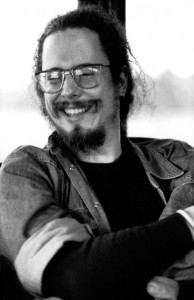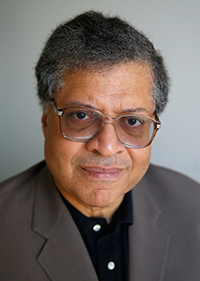The first time I heard him play was sometime in 1988 on an LP (ask your parents, kids, because I hear they may be coming back) entitled, The Sex Queen of the Berlin Turnpike, a jazz-and-poetry mix written and produced by a central Connecticut crony of mine named Vernon Frazer, novelist, raconteur, boxing aficionado and bass player who’d provided musical accompaniment to his readings here and, in years to come, at such venues as the Nuyorican Café and the Knitting Factory.
As I listened, I became acutely aware of this flute coiling around Vern’s incantations and bass lines in lucid, deceptively simple patterns. As I grew up a flautist manqué, however reluctantly, I paid attention when people did unexpected things with the instrument, especially in jazz. And whoever was playing had nailed down a lyrical, probing style that refused to lean heavily on the flute’s naturally pretty tone. (The tone wasn’t pretty. It was beautiful, rich and – was it possible? – evenly layered.) And then I heard the alto sax solos. They could burn like scalding water. But they also soared; sometimes like jets, other times like gliders. More than anything, it was the relentless invention, the let’s-try-anything ingenuity that knew how to swing, bop and blow the blues in the grandest manner, but could step “outside” conventional changes with a nonchalance that seemed highly evolved even for the greyest of beards.
I checked the name on the cover: Thomas Chapin. Hadn’t heard of him before that point and was chagrined at myself for not paying attention. I’d assumed he was this lesser-known veteran of the black music wars who likely spent the previous decade-and-a-half trolling through lofts along the eastern seaboard. “Who is this Thomas Chapin cat?” I wrote Vern, who in turn told me he was this barely-thirty-something white guy from Manchester, Connecticut.
Manchester? Really? I’d spent part of my early newspaper years writing about that east-of-the-river suburb and, whatever its myriad virtues and defects, the next-to-last thing I’d have expected was someone who could wail like this. When I played this record to another colleague from those long-ago Hartford Courant days, his head swiveled as sharply as mine had to the sound of Chapin’s alto. When I told him who was playing and where he was from, my friend shook his head. “Shit, man,” he said. “Nobody from Manchester ever blew like that!”
It’s been fifteen years since Thomas Chapin died at just 40 years old and I still find myself wondering what he’s been up to. I keep thinking he’s got to be on some club’s weekend schedule, leading a trio or quartet in support of a new disc or performing yet another homage to his idol Rahsaan Roland Kirk. No matter where Tom would be, he would be turning heads, winning friends, encouraging people to come over to his side, no matter how forbidding or unconventional the setting. That’s what he always did, on- or off-stage. That’s why we miss him.
He was a member in good standing of the crowd of cutting-edge dynamos who waved the progressive-jazz banner throughout the eighties and nineties in downtown New York (a scene whose central HQ was that aforementioned Knitting Factory). Yet he also turned heads among more-traditional-minded listeners as a distinctive and highly accomplished post-bop player with a bright, lightly jagged tone and a prodigious, often-stunning range of expression. As with generations of musicians who had apprenticed under Lionel Hampton (in whose big band he’d worked for five years), Chapin carried “Gates’s” lessons of brash showmanship in his own trick-bag. But he never pandered to or shortchanged expectations, whether swinging from the core of a hard-bop standard or generating torrents of chromatic density off a simple riff.
The straight-ahead side blooms like fireworks on Never Let Me Go (Playscape), a recently-released triple-CD of Chapin leading quartets at two New York venues. The first two discs are from a November, 1995 show at Flushing Town Hall with pianist Peter Madsen, bassist Kiyoto Fujiwara and drummer Reggie Nicholson. The third disc teams Chapin and Madsen with the bass-drum tandem of Scott Colley and Matt Wilson at the Knitting Factory on December 19, 1996 – Chapin’s last live date in New York City. (He’d been diagnosed with leukemia the following year.) Though Chapin’s last studio recording, 1997’s Sky Piece, remains the one true gateway to his life’s work, Never Let Me Go evokes the warmth of Tom’s personality and the exhilaration he could communicate even to those who may not have fully appreciated his chosen idiom.
Ecstasy leaps from the first track, “I’ve Got Your Number,” whose chord changes provide a gauntlet for Chapin’s breakaway speed and power. There was never anything tentative about his attack; not even when, on the silky “Moon Ray,” the tempo gears down to stealth mode and Tom summarily shifts to shrewder thematic tactics. Along with his many other gifts, Chapin easily complied with Lester Young’s directive to “sing a song” when he played – which meant, as Prez suggested by example, to find the songs within the song that needed to come out. More than most of his downtown confreres, Chapin always exercised this prerogative, even on songs that weren’t part of the classic-pop canon as exhibited here on both “You Don’t Know Me” and “Wichita Lineman,” whose melodies Chapin irradiates with such conviction that you get the feeling he could have, in time, single-handedly embedded them both in the traditionalist fake-book.
His own compositions become occasions for Chapin’s more imaginative dramas of harmony and rhythm doing their approach-avoidance ritual. These are most prominent on the Knitting Factory gig; it must be noted that Matt Wilson, whose own embraceable style and personality are mirror images of Chapin’s, opens wider terrain for both Madsen and Chapin to lunge at the edges of time and space. On such pieces as “Big Maybe” and “Flip Side,” whatever ambiguities, discordances and incongruities play their way through each solo do so from a solid core, which Wilson tends with inviolate calm, but also with a gentle persistence of vision. Madsen makes his presence even more pronounced on the latter set; he builds his own model airplanes to fly as eccentrically, yet as emphatically as Chapin’s own. Together, this group could have helped make the cutting-edge a place where all would be welcome, exalted and, eventually, transformed. It’s nice to think so anyway.
When someone dies as prematurely as Chapin, there usually come in his wake several voices inspired by his example to fill the void. (Think of all those bright, hot horns who picked up where Clifford Brown left off. Or all those actors who are still filling in the blanks left behind by James Dean’s car crash.) In the decade-and-a-half since Chapin’s death, those examples are harder to find, especially his ability, or more accurately, his impulse, to bridge the gap between progressive and traditional jazz music – or to, at the very least, extend what critic Jim Macnie characterized as the “dialogue” between two wary, warring factions. As jazz kept shifting shape at the close of the century, bending and twisting itself into new forms while struggling with how much of its past forms it should retain (or shed), Thomas Chapin offered a model for the music’s future by making his own art pliant, inquisitive and open enough to accept whatever the times demanded. I don’t know whether the “amalgam of freedom and discipline” described in Chapin’s Allmusic.com biography could have slowed down or even stopped jazz’s free-fall in a music marketplace that became even more mercurial after his death. But I’m far from alone in wishing he’d had more time to try.

